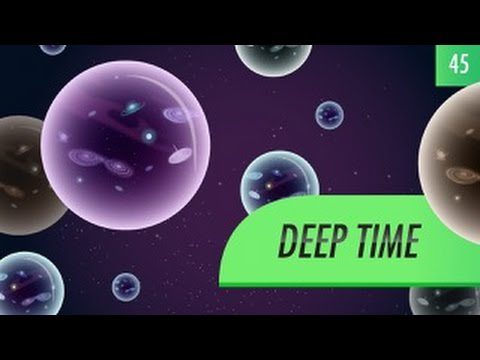Pe măsură ce ne apropiem de sfârșitul Crash Course Astronomy, acum este timpul să recunoaștem că zilele Universului nostru sunt numărate. Stelele se vor stinge după câteva trilioane de ani, protonii se vor descompune și materia se va dizolva după o mie de trilioane de trilioane de ani, găurile negre se vor evapora după 10^92 de ani și apoi toate vor fi întunecate. Dar există încă speranța că din el se va naște un nou Univers.
Consultați posterul despre sistemul solar Crash Course Astronomy aici: http://store.dftba.com/products/crashcourse-astronomy-poster
Dacă doriți să aflați mai multe despre crearea și moartea universului, urmăriți Crash Course Big History aici:
—
capitole:
Introducere: Sfârșitul Universului 00:00
Notația științifică 1:34
Cele cinci epoci ale universului 2:20
Era primordială 2:52
Era Stelliferous (Ești aici!) 3:05
Era degenerată 4:48
Era găurii negre 7:42
Era întunecată 9:39
The Big Rip 10:20
Alte posibilități: Multiverses & The Cosmic Reboot 11:52
Revizuire 14:10
—
PBS Digital Studios: http://youtube.com/pbsdigitalstudios
Urmărește-l pe Phil pe Twitter: https://twitter.com/badastronomer
Doriți să găsiți Crash Course în altă parte pe internet?
Facebook – http://www.facebook.com/YouTubeCrashCourse
Twitter – http://www.twitter.com/TheCrashCourse
Tumblr – http://thecrashcourse.tumblr.com
Asistență CrashCourse pe Patreon: http://www.patreon.com/crashcourse
—
Resurse Hawking Radiation Mechanism:
https://en.wikipedia.org/wiki/Hawking_radiation
http://math.ucr.edu/home/baez/physics/Relativity/BlackHoles/hawking.html
http://casa.colorado.edu/~ajsh/hawk.html
http://physics.stackexchange.com/questions/154647/how-does-the-hawking-radiation-mechanism-cause-a-black-hole-to-lose-its-mass
FOTOGRAFII/VIDEOCLIPURI
Câmpul Hubble ACS SWEEPS http://hubblesite.org/gallery/album/star/star_field/pr2011016b/ [credit: NASA, ESA, W. Clarkson (Indiana University and UCLA), and K. Sahu (STScI)]
Flare https://www.cursuriaz.ro/wp-content/uploads/localimages/dg_cvn_flare_final_4k_0.jpg [credit: NASA’s Goddard Space Flight Center/S. Wiessinger]
Hubble vede Geneza stelară în Roata de Sud http://hubblesite.org/newscenter/archive/releases/2014/04/image/a/ [credit: NASA, ESA, and the Hubble Heritage Team (STScI/AURA)]
Pitic alb http://www.nasa.gov/multimedia/imagegallery/image_feature_468.html [credit: NASA, ESA, H. Bond (STScI) and M. Barstow (University of Leicester)]
Steaua de neutroni ilustrată https://www.cursuriaz.ro/wp-content/uploads/localimages/a-3ENeutron_star_illustrated.jpg663a20b4ccd97.jpg [credit: NASA, Casey Reed – Penn State University]
Găuri negre: monștri în spațiu http://www.nasa.gov/mission_pages/nustar/multimedia/pia16695.html [credit: NASA/JPL-Caltech]
Video cu stele de neutroni binar https://nasaviz.gsfc.nasa.gov/vis/a030000/a030500/a030569/slide_04-B3_CWDB_inspiral.mp4 [credit: NASA]
Galaxia eliptică gigantică NGC 1316 în clusterul Fornax https://www.eso.org/public/images/eso0024a/ [credit: ESO]
Proton Aurora http://svs.gsfc.nasa.gov/cgi-bin/details.cgi?aid=20099 [credit: NASA/Goddard Space Flight Center Conceptual Image Lab]
O cursă în jurul unei găuri negre http://www.nasa.gov/centers/goddard/universe/blackhole_race.html [credit: NASA/Dana Berry, SkyWorks Digital]
Big Bang-ul http://svs.gsfc.nasa.gov/cgi-bin/details.cgi?aid=10128 [credit: NASA]
Hubble Ultra Deep Field 2014 http://hubblesite.org/newscenter/archive/releases/2014/27/image/a/ [credit: NASA, ESA, H. Teplitz and M. Rafelski (IPAC/Caltech), A. Koekemoer (STScI), R. Windhorst (Arizona State University), and Z. Levay (STScI)]
Galaxie http://apod.nasa.gov/apod/ap150614.html [credit: Subaru Telescope (NAOJ), Hubble Space Telescope, Robert Gendler]
O stea, multe stele (M13) http://www.deepskycolors.com/archive/2011/05/04/one-star-many-stars-M13.html [credit: Rogelio Bernal Andreo]
Pământ https://www.nasa.gov/content/goddard/earth-from-space-15-amazing-things-in-15-years [credit: NASA’s Earth Observatory]
Video cu explozie [credit: Shutterstock / Richard Finch]


I am more scared of what we don't know
This gives me anxiety
“The” should be replaced with “Our”
Cold , and empty !
I like it that way .
I hope that in the afterlife you can’t feel time pass. No matter how I look at it this video gives me existential dread lol. But I love it!
isnt everyone just earth since when we are born we know we will be buried.
Time keeps on slipping into the future
Maybe it's humans' job to prevent the big freeze.
hey crash course, do you have any recommended readings for an adult with no astronomically educated background who has become incredibly interested by this series?
But… doesn’t the zeroth dimension suggest that when the universe “dies” it will “go backwards” and be “reborn”?
Yes!!!! The zeroth dimension. Basically, The universe just keeps dying and being reborn over and over. I heard somewhere its like the universe expanding then imploding. Whats too say its going “forward” now and backwards later. Or vice versa.
What if space time is like a rubber sheet and the Big Bang is why it’s stretching along with everything else, but at some point it stops stretching and starts contracting slow at first then increasingly fast until it all comes back to a point of singularity starting the whole process all over again